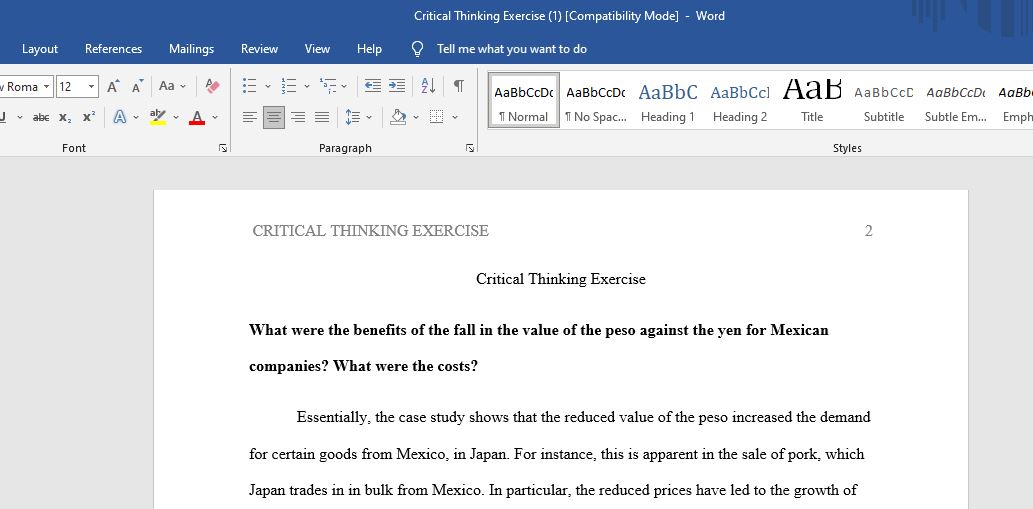Critical Thinking Exercise.
Your initial posts will be due by Sunday of each week of the module. All original threads should be at least 250 words. This parameter helps to promote writing that is thorough, yet concise enough to permit other students to read all the postings. The thoughts and opinions expressed in your thread need to be substantiated by research and literature (from the textbook or outside sources). All references should be in correct APA style. Relate issues to personal experience. Rationally defend your stated position.
The Mexican Peso, the Japanese Yen, and Pokemon Go
This activity is important because, as a manager, you must be able to understand the influence of exchange rates on the profitability of trade and investment deals. Unfavorable changes in exchange rates can make profitable deals unprofitable.
The goal of this exercise is to demonstrate your understanding of the foreign exchange market, how exchange rates influence profitability, and the three types of exchange rate exposure: economic, translation, and transaction.
Read the case and answer the questions that follow.
Nintendo’s hit game Pokemon Go is a lot less lucrative in Mexico than the Japanese company originally thought it would be. This is because Mexicans purchase the “Pokecoins” they need to navigate the game in Mexican pesos, and the peso has been falling in value against the Japanese yen. Back in early 2015, 1 Mexican peso bought 8 Japanese yen. By September 2016, 1 peso was only worth about 5.1 Japanese yen. This meant that when pesos spent on Pokemon Go were translated back into Japanese yen, they were worth less in yen, which negatively affected Nintendo’s profits from Mexico.
The diverging values on the yen and peso are a function of their exchange rates against the U.S. dollar. Most trades between the yen and the peso are converted through the U.S. dollar, rather than traded directly. This is because the U.S. dollar is the world’s most widely traded and liquid currency. It’s easier to trade dollars for yen, and dollars for pesos, than it is to trade yen for pesos. For much of 2016, the yen gained against the dollar, while the Mexican peso fell, leading to a fall in the peso/yen exchange rate.
The strength of the yen reflected the belief that Japan is a safe haven in which to park cash. Although the Japanese economy has been stagnant for decades, inflation is low and the yen has been a strong currency. The Mexican peso is the most liquid emerging market currency, which makes it an easy one to sell when investors worry about the economic strength of developing economies, which they did in 2015 and 2016. To compound matters, worries about the health of the Mexican economy following the election of Donald Trump to the U.S. presidency put further pressure on the peso. Trump threatened to pull the United States out of NAFTA—the regional trade deal that has been a major boon for Mexico. The Mexican peso hit a record low against the U.S. dollar following the election of Mr. Trump.
In addition to Nintendo, the fall in the value of the peso against the yen has created problems for other Japanese firms. Japanese automakers have significant assembly operations in Mexico. Companies such as Toyota and Mazda import a large number of specialty electronic components from suppliers in Japan. The price of these components has gone up when translated into pesos, raising costs for their Mexican operations and making them less profitable.
On the other hand, the weak peso has boosted demand for some Mexican products in Japan. For example, Japan imports a large quantity of frozen Mexican pork. The price has fallen when translated into yen and demand has surged. Mexico dices up the pork and exports it to Japanese convenience stores, where it is sold in bento boxes. The dicing process is labor intensive—and one less step they have to perform in Japan. Mexico can do it cheaper, and the currency moves have only added to the cost savings, which is good for Japanese consumers.
Sources: Julie Wernau, “Pokeman Go Illustrates a Currency Problem,” The Wall Street Journal, August 11, 2016; Elena Holodny and Portia Crowe, “Mexican Peso Crashes to Record Low,” Business Insider, November 8, 2016; and “Peso Falls to Session Lows after Meeting between US and Mexico Presidents Falls Through,” Reuters, January 26, 2017.
What were the benefits of the fall in the value of the peso against the yen for Mexican companies? What were the costs?
Should Japanese companies with business in Mexico, such as Nintendo and Toyota, have hedged against adverse changes in the peso/yen exchange rate? How might they have done that?

word limit:313
